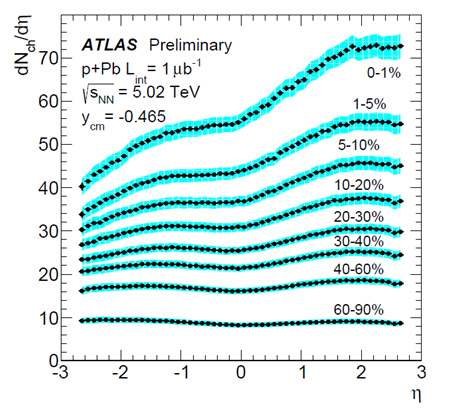Quark-Gluon Plasma search
We are studying the new state of matter called the Quark-Gluon Plasma (QGP), one of the most exciting discoveries of recent decade. An extensive experimental program of Relativistic Heavy Ion (RHI) collisions carried in the leading world laboratories succeeded to achieve so high energy densities that the smallest constituents of ordinary matter, quarks, bound together by a fundamental law of quantum chromodynamics (the law of confinement) are set asymptotically free. This is the the top-most phase transition the matter can undergo reaching the temperatures of 2500 GigaKelvin - more than 100000 times hotter than the core of the Sun.
The ATLAS experiment at CERN is the most sophisticated particle detector ever built. It is also the largest one among the LHC experiments which took its first data in fall of 2009. The ATLAS experiment offers an excellent opportunity to study the QGP under new unprecedented conditions of almost 30 times more incident energy than reached before. The analysis of the physics data will allow physicists to widen the horizons of QGP understanding and investigate its properties under the new regime.
The MEPhI Heavy Ion group is engaged in the study of relativistic nuclear collisions in the framework of the ATLAS experiment at CERN. MEPHI group is the part of the Heavy Ion Working Group of the ATLAS experiment and focuses mainly on the experimental data analysis:
- Measurement of the centrality dependence of the charged particle pseudorapidity distribution in proton-lead collisions;
- Transverse momentum, rapidity, and centrality dependence of inclusive charged-particle production in p+Pb collisions;
- Measurement of Z boson production in Pb+Pb Collisions;
The analyses are carried out in collaboration with Columbia University (US), Brookhaven National Laboratory (US), CERN (EU), Weizmann Institute of Science (Israel). Our most important results are shown below.
Left plot shows the results of the Z bosons mass reconstructed via dielectron and dimuon decay channels. The per-event Z boson yield is proportional to the number of binary collisions estimated by the Glauber model within the statistical and systematic uncertainties.
The measurements of the centrality dependence of the charged particle pseudorapidity distribution (central plot) , dNch/dη, in p+Pb collisions, point to the importance of understanding not just the nuclear wave function initial state, but also the fluctuating nature of nucleon-nucleon collisions themselves.
The per-event invariant yields for inclusive charged hadrons in p+Pb collisions (right plot) allows to investigate the gluon distribution in the lead-ion target and contribute to the study of non-linear saturation effects that may be present in the Pb and proton wave functions

Pic 3. Centrality dependence of the charged particle pseudorapidity distribution dNch/dh, in p+Pb collisions.
Papers and conference talks:
- ATLAS Collaboration; «Measurement of Z Boson Production in Pb-Pb Collisions at √(SNN)=2.76 TeV with the ATLAS Detector»; Phys. Rev. Lett 110, 022301 (2013)
- ATLAS Collaboration; «Measurement of the centrality dependence of the charged particle pseudorapidity distribution in proton-lead collisions at √(SNN) = 5.02 TeV with the ATLAS detector»; ATLAS-CONF-2013-096
- ATLAS Collaboration; «Transverse momentum, rapidity, and centrality dependence of Charged Particle Production in p+Pb √(SNN)=5.02 TeV collisions measured by ATLAS experiment at the LHC»; ATLAS-CONF-2013-107
- Shulga, E; «Centrality dependence of charged particle production in proton-lead collisions measured by ATLAS»; Int. Conference on the Initial Stages of High-Energy Nuclear Collisions. 8-14 September 2013
Contact Person:
Shulga Evgeny
evgeny.shulga@cern.ch




